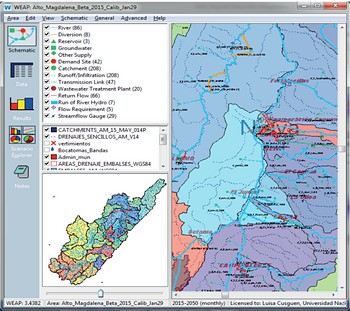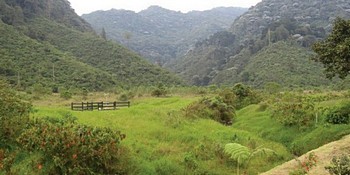A symposium on 3 June in Bogotá will bring together experts from water management institutions and academia to share lessons from a major USAID-funded project on climate change adaptation.
The Río La Vieja, in Colombia's coffee-growing region (Eje Cafetero). Flickr / Ben Bowes
Three years ago, with support from the U.S. Agency for International Development (USAID), SEI launched the project “Ríos del Páramo al Valle, por Urbes y Campiñas” (rivers from the moorlands to the valleys, through cities and countryside). The aim was to develop capacity for climate change adaptation in water resources management in Colombia’s coffee-growing region and other areas.
Since then, the project team has worked closely with stakeholders to develop WEAP models of the Río La Vieja and Alto Magdalena watersheds, built local capacity for water resources planning and adaptation, and worked to strengthen local institutions.
A symposium this Wednesday, 3 June, in Bogotá, “Water, Climate and Adaptation”, aims to provide a space for dialogue amongst experts and decision-makers about the lessons learnt about climate change adaptation through the use of tools and local capacity built through the project.
“This dialogue builds on our work over the last three years, backed by USAID, in which we have used technical information from models to examine the future of these watersheds under different external pressures from climate change and development,” says Marisa Escobar, a senior scientist at SEI-US in Davis, Calif., and native of Colombia who has led the project.
“This information, built into a participatory process, has enabled us to identify the adaptation measures that would best meet sectors’ water needs in the face of future uncertainties,” she adds. “It has also allowed the technical staff of the Corporaciones Autónomas Regionales [the regional bodies that manage water resources] to learn about methods to quantify the effects of climate change and understand adaptive capacity in the watershed.”

Colombia’s National Policy for Integrated Water Resources Management (PNGIRH) has enabled important advancements in legislation and in planning processes. Still, the challenges faced by decision-makers trying to plan for the future of key watersheds are complex, riddled with uncertainty. The process is further complicated by the violence in Colombia’s recent past; key decisions about future development are closely linked with the peace and reconciliation process.
“Watershed planning in Colombia with a view to adapting to climate change is of crucial importance for ensuring that development associated with the peace process is sustainable,” Escobar says.
In this context, the Ríos del Páramo al Valle project aimed not only to provide improved technical tools to support decision-making, but also to develop participatory processes that could engage a broad range of stakeholders in identifying key challenges and finding solutions.
By adapting the RAND Corporation’s robust decision-making approach to local needs (in an approach dubbed “Robust Decision Support”), SEI has worked to create a systematic process for gathering and analysing information, with stakeholder participation at every key step. A wide range of partners in Colombia have been worked on the project, resulting in a substantial capacity-building that will benefit the region well after the project is finished.
The symposium is structured as a series of techno-political dialogues, each including a technical adviser, a policy adviser, and a decision-maker. Participants will be asked for feedback about the project results, and about the potential for the tools and methodologies developed through the project to strengthen planning processes. They will also be asked about expectations and plans for the future.
“This is a chance to bring together regional water management leaders with the people who define policies at the national level, to establish a dialogue about how to tackle adaptation in watersheds in Colombia,” says Escobar.
After an introduction by Escobar, there will be a session on technical advances and participatory methods to support adaptation in the water sector, focusing on different components of the project – e.g. modelling done in Alto Magdalena, “where Colombia’s water is born”. A second session will focus on connecting regional- and national-level decision-makers, and a third on the specific needs of the Zona Cafetera (the coffee-growing region). The final session will look more broadly at lessons learnt across the region and at financing options for implementing adaptation measures.
Learn more about the project »
Visit the project blog (external link)

Design and development by Soapbox.

